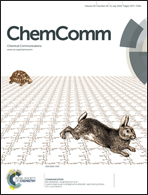[{Cu(IPr)}2(μ-OH)][BF4]: synthesis and halide-free CuAAC catalysis†
Abstract
The preparation under protic conditions of the first μ-hydroxo dicopper(I)–NHC complex is reported. Its application as a CuAAC catalyst was investigated, evidencing a remarkable enhancement of catalytic efficiency in the presence of 4,7-dichloro-1,10-phenanthroline and highlighting the beneficial effect of the absence of coordinating halides.
![Graphical abstract: [{Cu(IPr)}2(μ-OH)][BF4]: synthesis and halide-free CuAAC catalysis](/en/Image/Get?imageInfo.ImageType=GA&imageInfo.ImageIdentifier.ManuscriptID=C4CC03346A&imageInfo.ImageIdentifier.Year=2014)

 Please wait while we load your content...
Please wait while we load your content...